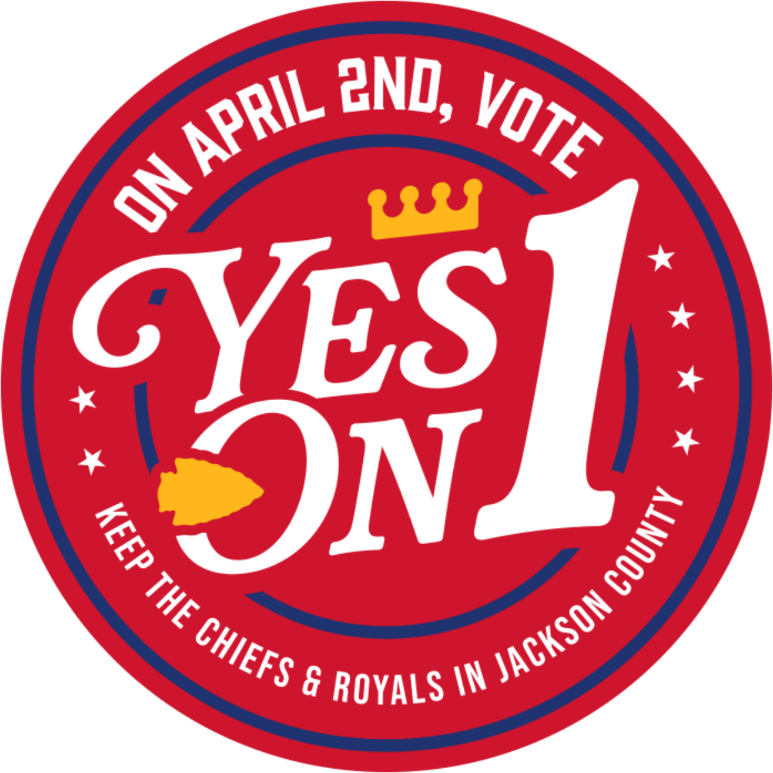Is a new Royals downtown stadium a good idea?
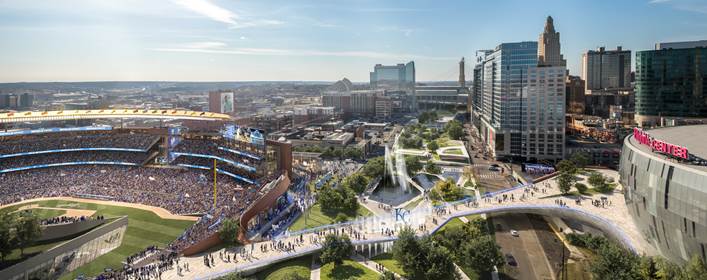
Spoiler. I’m voting YES on April 2.
Some of the reasons to vote NO are legitimate, and I appreciate that it’s hard to strike a balance that satisfies all stakeholders.
I’m not trying to change any minds here. Priorities differ. I just want to share why I am voting yes. As a baseball fan. Two broad reasons:
1. Downtown baseball is cool.
2. The Royals owners are local and have a history of supporting our community. I think that’s what they are trying to do here. And willing to lock the team in for the next 40 years.
Six years ago, quite by accident, I speculated about a Royals stadium between the Power and Light District and the Crossroads. At the time, David Glass owned the Royals, and I’m confident he was not thinking of moving downtown. Here’s my story.
In 2018, Rita and I took a bus tour to see games in MLB stadiums in Pittsburgh, Cleveland, Cincinnati and Atlanta. I chronicled the trip in Hot Stove #77, and there are a couple of quotes that have relevance to my topic today.
2018 Tour – Atlanta Braves: In 2017, the Braves moved from Turner Field in Atlanta to SunTrust Park in suburban Cobb County, Georgia. The Braves created a 60-acre baseball district with new hotels, residences, retail and offices. In the photo below, you can see the skyline of downtown Atlanta on the horizon (13 miles away).

I don’t like the isolated location of the Braves stadium, far from the heartbeat of the city. But we found one part of the experience positive. As then reported in Hot Stove:
SunTrust Park: This was our final stop on the trip. SunTrust Park opened in 2017 and so it is the newest in the majors. It’s a nice stadium, but we were most impressed by “The Battery,” a retail, dining, apartment and hotel development that has built up around SunTrust Park. We stayed in one of the hotels and walked over to our 4:10 game between Atlanta and Baltimore. The Battery was jammed with people both before and after the game. To get a feel for the vibe, imagine Kauffman Stadium relocated between the Power and Light District and the Crossroads.
I’ll repeat that last sentence for the speed-readers: To get a feel for the vibe, imagine Kauffman Stadium relocated between the Power and Light District and the Crossroads.
As noted earlier, when I wrote this in June of 2018, David Glass owned the Royals and downtown baseball was not on the horizon. But in an intriguing coincidence…
2018 Tour – Cleveland Indians (now the Guardians): Before the Atlanta stop, we were in Cleveland. An excerpt from Hot Stove:
After our overnight stay in Pittsburgh, we took a 3-hour bus ride directly to Progressive Field where the Indians were playing an afternoon game against the White Sox. The Indians lead the AL Central, while the White Sox are fighting the Royals for the division basement. Through the kindness of a good guy from Kansas City with ties to the Indians, we sat for a few innings in front row seats behind the Cleveland dugout.

The “good guy from Kansas City with ties to the Indians” was John Sherman, citizen of Kansas City and a minority owner of the Indians.
I met John in April of 2017. Rita and I attended the annual “Wild About Harry” fundraiser for the Truman Library. By a stroke of luck, we were seated at a table with two of the presenting sponsors of the dinner, Marny and John Sherman. Also at the table was one of the honorees of the evening (and an idol of mine), Congressman John Lewis (RIP). My photo…
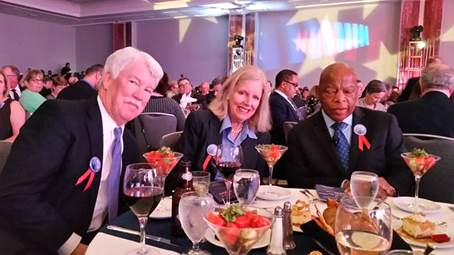
I was of course pleased to sit next to a major league owner and selfishly took advantage by bending his ear about baseball. The AL Central Division that had both Cleveland and Kansas City. The Negro Leagues Baseball Museum with its ties to the Cleveland World Series winners of 1948 (Larry Doby and Satchel Paige). The sad fact that Cleveland has not won a World Series since 1948. Baseball analytics.
I realized I was in the presence of a fellow baseball nerd, and, as you might guess, he was soon added to the Hot Stove mailing list.
I saw John again in the spring of 2018. He and Marny were hosting a KCUR public radio fundraiser at their home. I told him that Rita and I were soon going on a stadium tour that included a stop in Cleveland. He said he planned to be at our game and to text him when we got to the stadium. We did, and he came down to our seats and we had a good chat. That’s when he handed us the tickets behind the dugout, explaining that this is where he sat during the 2016 World Series.
Cleveland finished the 2018 season with their third straight Central Division title. John gave me a quote for Hot Stove:
“We are incredibly fortunate to be participating in our third straight postseason. One thing that I have learned from my three years of direct involvement with baseball is that the professionals never take it for granted. It is difficult to get there, particularly for small market teams. There is something special about October baseball. We all know from our experience in Kansas City in ’14 and ’15 that going deep in postseason baseball is exciting and can lift an entire community.”
He was a Cleveland owner, but he had not forgotten his hometown Royals.
2019 – David Glass Sells the Royals: In a surprise, David Glass decided to sell the Royals. It was rumored he might be ill. Glass was close to Ewing Kauffman and felt an obligation to sell to an owner who would likely keep the team in Kansas City. He reportedly targeted John Sherman because of John’s KC roots and his experience in baseball. The proposed sale to Sherman and his investment group was announced in August of 2019. The Kansas City Star headline:

Sherman’s passion for the Royals was in place long before he bought the team. From Alec Lewis in The Athletic: “Sherman has been described in many conversations…as a baseball romantic. He has long been so in tune with Royals baseball that, in 2014, with the club in the World Series, he was streaming the game on his phone one night during a family trip to Europe. His wife, Marny, noticed, looked him in the eye and told him to go back for Games 6 and 7. He did.”
When the proposed sale was announced, Cerner co-founder and Sporting KC owner Cliff Illig told the Kansas City Star, “If all the great sports writers got together and wrote a spec of what we needed in ownership in Kansas City, I’m not sure you’d be writing much that would be different than the strengths and capabilities that John Sherman has.”
Below, John Sherman, Commissioner Rob Manfred and David Glass, in November of 2019, when the American League approved the sale of the Royals. Sadly, Glass died two months later.
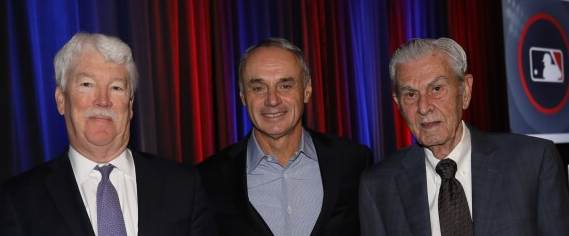
Royals Ownership: My serendipitous meeting of John Sherman at the 2017 Truman dinner gave me a pre-Royals view of a man with a passion for baseball. All I’ve seen since supports that view.
But it’s more than baseball. It’s also his passion for Kansas City. Sherman has been a major force in civic and philanthropic causes in Kansas City for decades. From the Truman Library and Teach for America to Big Slick and the Negro Leagues Baseball Museum. And countless others. Fittingly, he’s a former chair of the Ewing Marion Kauffman Foundation. The other members of the ownership group are also tied to Kansas City, and many are deep into the civic and philanthropic communities. Full list of owners here.
What this means to us? They want the Royals to always be in Kansas City.
Downtown Stadiums: Rita and I are working through our bucket list of MLB stadiums. So far, we have seen 25 of the 30. The ones that rise to the top of our favorites are generally those located downtown. One of our favorites is Petco Park, a beautiful stadium shoehorned into downtown San Diego. It is often at the top of the “Best MLB Parks” lists. More examples will be in Lonnie’s Jukebox below.
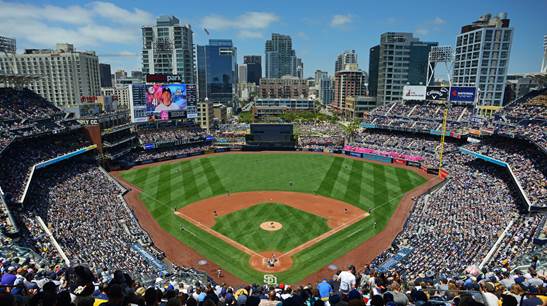
The games become part of the life of the city. The skyline serves as the backdrop of the stadium. Its boundaries are defined by the street grid.
Downtown Kansas City has made great progress in recent years. The visionary work of then mayor Kay Barnes created the Power and Light District and the T-Mobile Center, and they have in turn spurred more development and a streetcar line. Notably, the downtown population has increased 139% since 2000 to more than 32,000 residents.
A downtown stadium will help the city build on that success. A strong downtown has a ripple effect benefitting the entire metropolitan area. I sincerely believe that is a key motivator for the Royals ownership.
Proposed Sites: The Royals released renderings for two downtown sites: (i) East Village, at the eastern edge of downtown, to include its own entertainment district, and (ii) Crossroads East, as part of the existing city center.
There is concern by some in the city (and me) that an entertainment district in East Village would cannibalize the Power and Light District. Whereas a stadium in the East Crossroads would complement the Power and Light District and the balance of the Crossroads. The stadium would also be integral to the planned cap over the interstate that will create the South Loop urban park connecting downtown to the Crossroads.

I’m not forgetting the owners and tenants who would be displaced. But realistically, most big projects result in some displacement – there are many examples, including the NASCAR track, the Power and Light District and T-Mobile Center. Those displaced deserve fair payment that takes into consideration that they are being asked to sacrifice for the benefit of the community.
Modern Stadium: I love the K. Was there the day it opened on April 10, 1973; the heartbreaking playoffs against the Yankees in the 1970s; the first World Series in 1980; the 1985 World Series, especially Game 6; George Brett kissing home plate in his last game (9/29/93); and many more. I have the receipts. I miss ticket stubs.

But the K is nearing the end of its era. I’ve seen the talk about the concrete, but I find it to be a red herring. The question is whether Kansas City should move on to a modern baseball stadium. Below is a graph showing the relative ages of MLB stadiums. This is from 2016, so does not reflect new stadiums in Atlanta (2017) and Texas (2020). The number of years need to be increased by eight (the K is now in its 52nd year).

There are five other stadiums older than 50 years. Fenway and Wrigley (their own separate category). Two in Los Angeles. And Oakland – the A’s are leaving for Las Vegas (déjà vu – Charlie Finley moving the A’s from Kansas City to Oakland in 1968). The K is the oldest stadium for a small market team. The next four oldest stadiums are undergoing massive renovation (Toronto and Baltimore) or looking to new stadiums (Tampa Bay and the White Sox).
New Stadium Plans – 1967 and 2024: In 1967, the A’s and the Chiefs were playing in Municipal Stadium at 22nd and Brooklyn. Charlie Finley was constantly threatening to move the A’s. The Chiefs were not going to be willing to play long term in an old baseball stadium. Jackson County was then run by three administrative judges (Charles Curry, Alex Petrovic and Charlie Wheeler). They had been elected in a popular mandate and took the bold step of presenting several bond issues to the voters, including roads, hospital, parks…and stadiums. Their “Catch Up, Go Ahead” campaign went by the acronym CUGA.
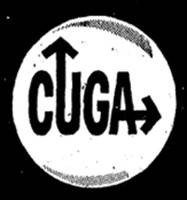
A two-thirds majority was required, and the stadium issue portion won with 68.9%. The voters did this knowing that the A’s might not be here (and they were not; Finley moved to Oakland in 1968). The voters did not know how much the state and city might contribute for ramps, infrastructure, etc. But they voted to provide a base for all parties to work from. And that was enough to coax the American League to expand and approve local entrepreneur Ewing Kauffman as owner. The teams and various levels of government then cooperated to make the Truman Sports Complex a reality. A more detailed account of this success story is in Hot Stove #97.
In 2024, we start from a better place with the Royals – the team is here and has strong local ownership (no Finley issue). The county is again in position to take the first step. Like they did in 1967. The city and state have indicated a willingness to participate if the county is committed to a new stadium. This is not a blank check for the Royals. The county funds are subject to monitoring by the bipartisan Jackson County Sports Authority. The vote on April 2 commits no city or state money. That will be subject to negotiations, as well as zoning and planning hurdles at the city. In all events, the Royals will bear a substantial share of the cost and be responsible for any stadium cost overruns.
Yes, I’m an optimist. But with history to support.
A 40-Year Commitment: The Royals have committed to a 40-year lease. So, there is also this…

Batter up Jackson County. Let’s get a rally going.
Lonnie’s Jukebox – Downtown Stadiums Edition: Now a look at a few downtown stadiums matched up with some rock ‘n’ roll vibes.
The graphic below shows the distances from downtown for all MLB stadiums. The Royals are one of five teams outside the 5-mile line. Two are in NY (cost of land in Manhattan is prohibitive, and there is an extensive subway system). The Braves are now in Cobb County, Georgia. Texas has always played in Arlington, a midway point between Dallas and Fort Worth.
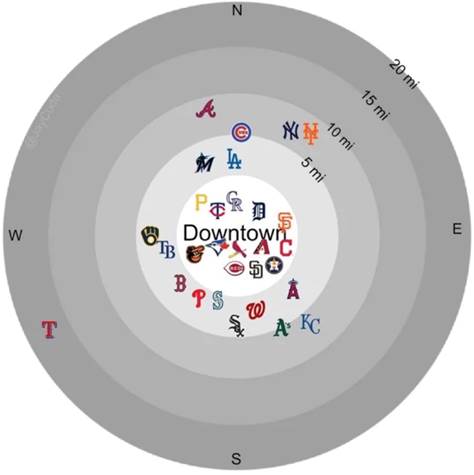
Some downtown stadiums Rita and I have seen while working on our bucket list.
. 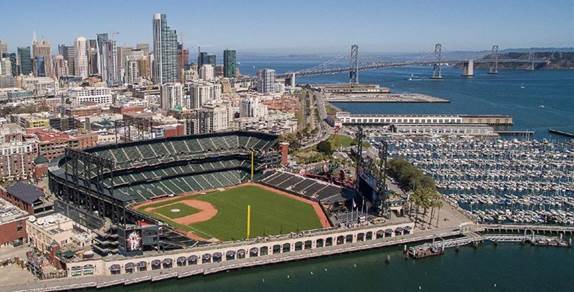
San Francisco Giants – Oracle Park. It’s still hard for me to not say AT&T Park, but the name changed in 2019. Hard to beat looking out on San Francisco Bay.
“Don’t Stop Believin’” by Journey. Lead singer Steve Perry is a superfan of the Giants, and this song is played during the 8th inning at Giants home games. Perry sometimes leads the crowd in the song (as he did when the Royals and Giants played in the 2014 World Series). Here is a sample from an NLCS game (click here).

Baltimore Orioles – Orioles Park at Camden Yards. The original “retro” park. It was completed in 1992, and baseball fans around the country came to pay homage. Rita and I got there in 1993.
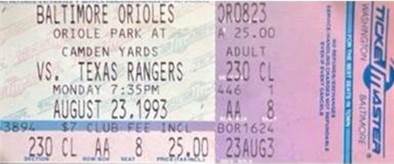
“Thank God I’m a Country Boy” by John Denver. Played in the 7th inning stretch at Camden Yards. Denver performed it atop the Orioles dugout in Game 1 of the 1983 World Series.
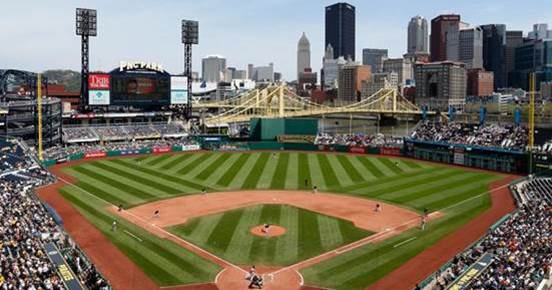
Pittsburgh Pirates – PNC Park. The most striking part to me is the center field view of the Roberto Clemente Bridge connecting the stadium and the office district. When I think of baseball music from Pittsburgh…
“We Are Family” by Sister Sledge. At the request of Willie Stargell in 1979, this became the official clubhouse theme song, and the Pirates went on the win the World Series.
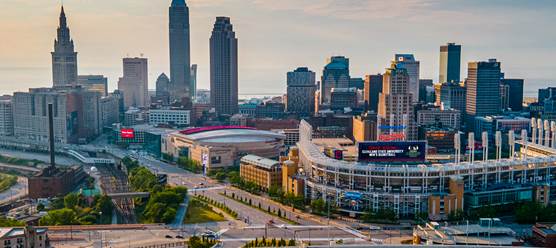
Cleveland Guardians – Progressive Field. Where Rita and I chatted with John Sherman in 2018. Within walking distance of the Rock and Roll Hall of Fame.
“Cleveland Rocks” from the Drew Carey Show. The cast dances its way to Jacobs Field (the stadium name until 2008).
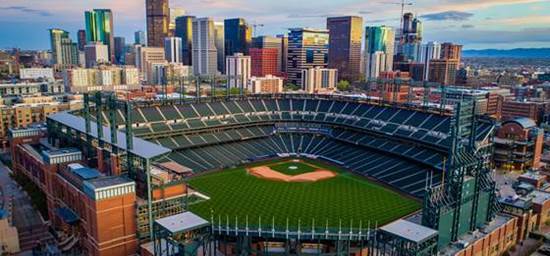
Colorado Rockies – Coors Field. In LoDo, the Lower Downtown neighborhood of Denver. Also has views of the mountains.
“Rocky Mountain Way” by Joe Walsh. Played after wins at Coors Field.
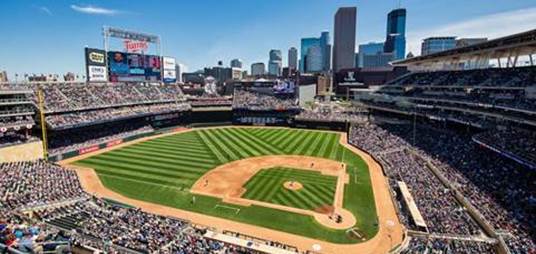
Minnesota Twins – Target Field. Nestled into downtown next door to the city’s arena (Target Center, featuring a red-eyed Target dog that wags its lighted tail as seen from the baseball stands).
“Little Red Corvette” by Prince. For the 7th inning stretch, the Twins go with Minneapolis native Prince.
